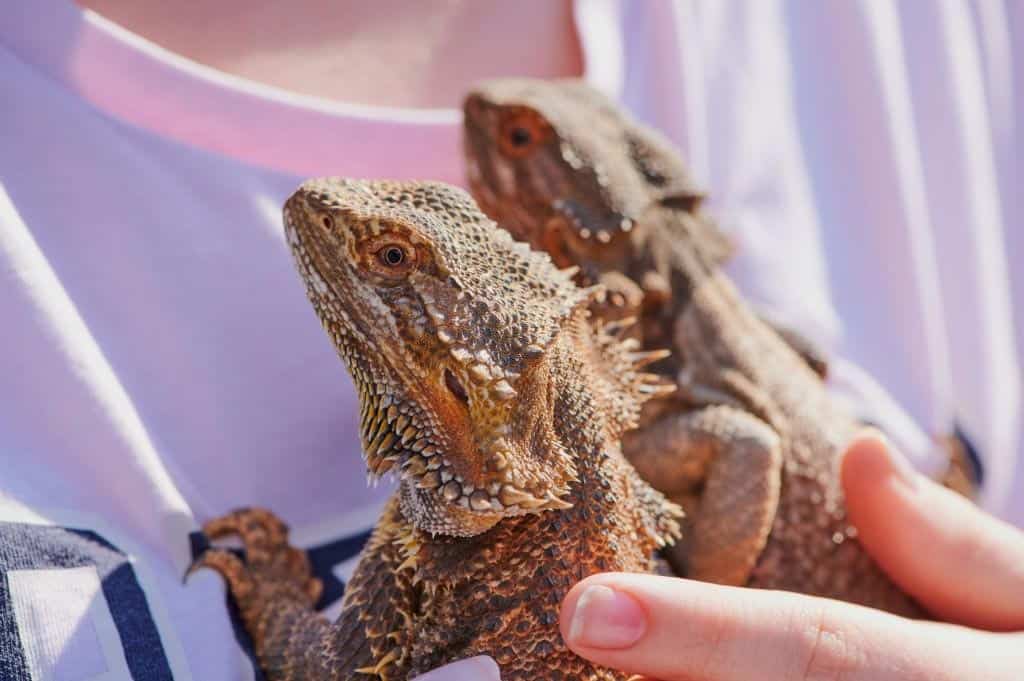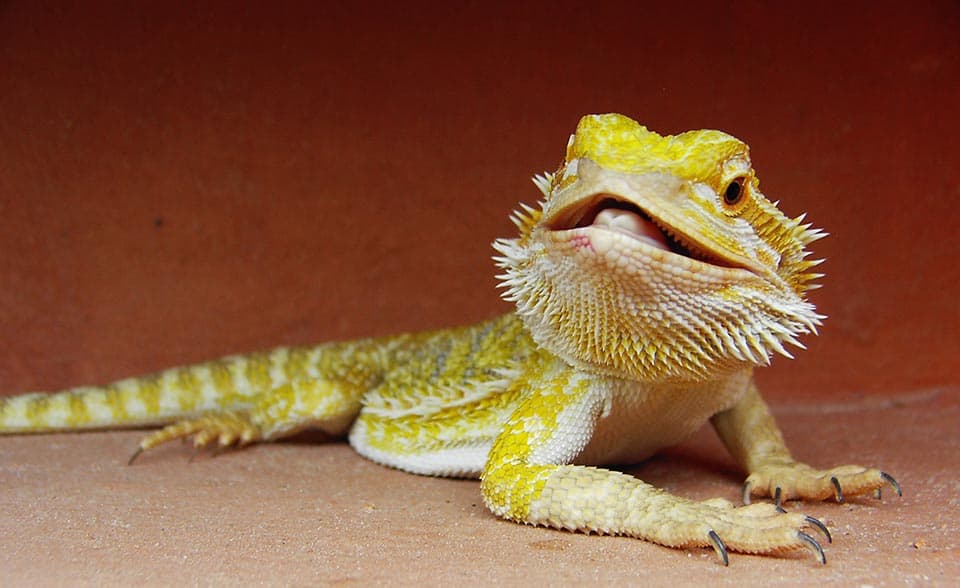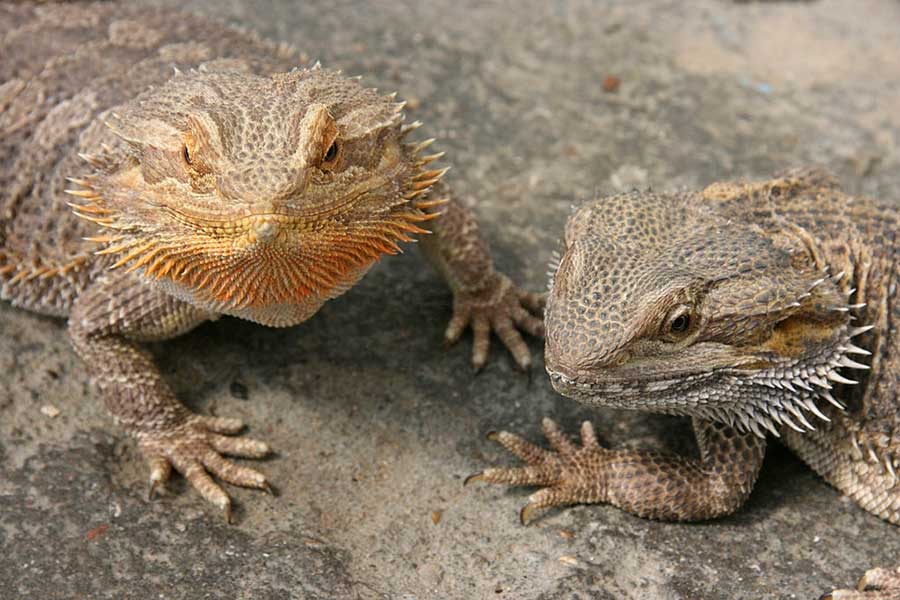Sexing bearded dragons can be tricky for new owners, especially if you don’t know what to look for! To make matters even more challenging, the subtle differences between a male vs a female bearded dragon become evident only as beardies fully mature.
If you have recently welcomed a bearded dragon into your home, you’re probably eager to find out how to tell whether your new pet reptile is a boy or a girl. Although caring for a male or female bearded dragon is mostly the same, knowing your reptile’s gender will help you better understand their behavior.
With several physical differences between male and female bearded dragons, sexing your reptile can be much easier than it seems…but only if you know what to look for!
Stay with me until the end of this article to discover how to tell the sex of your bearded dragon and the main differences between the two genders.
Main Differences Between Male vs Female Bearded Dragons
All bearded dragons younger than 8 weeks old look pretty much the same. If your beardie is still a hatchling, it’s best that you wait until they grow up a bit in order to sex them.
If you don’t know if your beardie is a boy or a girl, here’s how you can tell the difference:
- Size: Male bearded dragons are noticeably larger than females, whereas female bearded dragons have smaller heads, male beardies have larger, thicker, and wider skulls.
- Hemipenal Bulges: Male beardies have two hemipenal bulges, whereas females only have one.
- Beard: Male bearded dragons generally have darker and larger beards, especially during mating season, whereas female beardies have more inconspicuous beards.
- Femoral Pores: Male beardies have much larger, thicker, and darker femoral pores on the insides of their thighs, whereas females have much smaller, sometimes barely visible femoral pores.
We’ll discuss all these more thoroughly in the following sections.
4 Ways to Tell the Sex of Your Bearded Dragon
Native to arid deserts and other dry areas found in Australia, bearded dragons are increasingly popular pets. An interesting thing about this desert-dwelling reptile is that beardies start to develop prominent secondary sex characteristics as they mature.
Most experienced owners and breeders usually can distinguish between a male and female bearded dragon from a fairly young age.
However, if you’ve never owned a bearded dragon before, you might need to wait until your pet reptile is around 8 to 12 weeks old to tell its gender for sure. By this time, most juvenile beardies have calmed down a lot and are more likely to sit still long enough for you to look for distinctive physical traits.
Keep in mind bearded dragons become fully grown at 12 months of age, at which time you’ll be able to tell for sure whether your pet bearded dragon is male or female. However, if waiting a full year is too long, there are several ways to tell your beardie’s gender today!
To determine whether your bearded dragon is a male or female, you will need to look for certain physical and behavioral characteristics. Pinpointing these traits is the best and cheapest way of determining your beardie’s gender.
If you are curious about learning your bearded dragon’s gender use any of the following methods:
1. Look for Hemipenal Bulges
Looking at your beardie’s hemipenal bulges is probably the fastest and the easiest way of telling whether you have a male or a female pet dragon. Keep in mind, though, that hemipenal bulges aren’t noticeable in beardies less than four weeks old. So, if your beardie is still just a hatchling, you’ll need to wait for them to grow up a bit in order to more accurately sex them.
Hemipenal bulges are found on the underside of your bearded dragon’s tail, near their anus. Male beardies have two hemipenal bulges: one on each side of the tail base. Female beardies, on the other hand, have only one hemipenal bulge located in the center under her tail.
Now that you know what to look for, here are some tips on how to hold your beardie while inspecting their backside. Please note, if your bearded dragon isn’t used to being handled, you might have a hard time checking their hemipenal glands.
If your pet reptile doesn’t mind being held, start by gently holding the beardie’s stomach with the palm of your hand. Use your other hand to slowly lift your reptile’s tail up 90º. Lifting the tail will cause the skin to stretch a bit, making the hemipenal bulges easier to see.
Depending on your bearded dragon’s age and willingness to cooperate, you might have a hard time seeing the bulges at first. In this case, you can lift the tail a bit more to make the bulges pop. A word of caution though, don’t pull the tail or lift it too much, since doing so can anger your bearded dragon and make them difficult to hold.
If your beardie is a male, you’ll see two defined bulges running vertically down each side of the tail to the cloacal opening. If your bearded dragon is a female, there will only be a single bulge above the cloacal opening in the center of the tail.
Don’t forget that this method might not work for baby bearded dragons since their hemipenal bulges aren’t fully developed just yet. If your bearded dragon is less than eight weeks old, don’t expect to see any sign of hemipenal bulges just yet.
If you are having a hard time spotting the bulges with the naked eye, you may have better luck using the next method.
2. Try Using a Flashlight
This method is basically the same as the first one, but it is best done in darker conditions and with a flashlight. Position and hold your bearded dragon the same way you did the first time, gently lifting its tail and using a flashlight to shine through the base of the tail.
While you are shining the flashlight on the topside of your bearded dragon’s tail, you should observe the underside where the hemipenal bulges should be.
If your bearded dragon is a male, the hemipenal bulges will look like two shadows that are next to each other and run vertically down each side of the tail. If your beardie is a female, instead of two shadows, you’ll see a single bulge located in the center of the base of her tail.
With a strong flashlight, even the smallest hemipenal bulges will create shadows that will be clearly visible with a naked eye. This makes this method a highly accurate way of sexing bearded dragons, and you can also use it to determine the gender of hatchlings and juvenile bearded dragons.
3. Check the Size of the Femoral Pores
Another popular way of telling whether your bearded dragon is a male or female is by looking at the size of their femoral pores. Femoral pores look like spots and are found on the underside of your bearded dragon’s hind legs.
Both male and female bearded dragons have femoral pores and use them to secrete pheromones which help them communicate with other beardies. Most commonly, beardies excrete pheromones during the mating season.
However, although both males and females have them, femoral pores tend to be more pronounced and larger in male bearded dragons. If you can clearly see small circles running across the underside of your beardie’s hind thighs, your pet reptile is a male.
Female bearded dragons, on the other hand, have much smaller, less pronounced femoral pores than males. Sometimes, the pores are so small and faded that they are barely visible. If you have a hard time finding any spots or small circles on the inside of your beardie’s thighs, chances are, your pet is a female bearded dragon.
4. Observe Your Bearded Dragon for Certain Behaviors
Looking for specific bearded dragon behaviors might help you when sexing your beardie. However, this is the least reliable way of telling whether your bearded dragon is a male or female.
While experienced owners and breeders use these behaviors to distinguish male vs. female bearded dragons, novice owners will be better off using any of the other methods mentioned above.
Some owners and experts believe male bearded dragons are more likely to show aggressive and dominant behaviors such as stomping and hissing. Head bobbing and beard puffing are often signs of dominance and aggressive behavior that can be seen in many different situations.
On the other hand, female bearded dragons are more likely to show signs of submissive behavior instead of dominance. Juveniles and female bearded dragons often use arm-waving as a sign of submission or willingness to mate.
But although arm-waving is more commonly seen in females, male bearded dragons can also exhibit this type of behavior. So, before you declare that your beardie is a male or female based on specific behavior, double-check using one of the other methods.
Other Physical Differences Between Male and Female Beardies
Male and female bearded dragons possess distinctive physical traits and exhibit certain behaviors that become more prominent over time. All of these differences can be seen in adult beardies using the steps outlined above.
Besides hemipenal bulges and femoral pores, several other key differences can help you sex your pet reptile, including:
Head Size
If you pay close attention, you’ll soon realize there is a big difference between a male vs. a female bearded dragon’s head. Male bearded dragons typically have larger heads and much thicker skulls. Females have slightly smaller heads and more narrow skulls than male bearded dragons.
Tail Size
The size and the shape of a bearded dragon’s tail differ between the two genders. A male bearded dragon’s tail is much thicker at the base and stays thick all the way to the tip.
Although it can be thick at the base, the tail of a female bearded dragon is usually much thinner and more slender than a male’s tail.
The tail’s physical appearance is a great gender indicator. However, the difference doesn’t become apparent until bearded dragons become adults. So, if you have hatchlings or juvenile beardies, you’ll need to wait until they are around 12 months old to tell their gender based on the size of their tails.
Spikes
Both male and female bearded dragons have spikes around their heads, beards, and throats. In their natural environment, bearded dragons use these spikes as a defensive mechanism to stay protected against predators. When threatened or in danger, bearded dragons will puff up their bodies, which will, in turn, stiffen their spikes and create a more menacing appearance.
But while both sexes have them, male and female bearded dragons use their spikes differently. For the most part, male bearded dragons show off their spikes when they are ready to mate. They can also present spikes as a threat, in which case you’ll also notice hissing, mouth gaping, and black-bearding.
As opposed to males, female bearded dragons are more likely to use arm-waving when in the mood for mating. They usually extend their spikes only when threatened.
Dominant vs. Submissive Behaviors
Before you attempt to sex your bearded dragon based solely on their behavior, know that both males and females largely behave in the same ways. However, some behaviors are more often seen in males, while others are common for female bearded dragons.
Male beardies are more dominant and often show territorial aggression. Hissing, head bobbing, stomping, and beard puffing are some behaviors that are commonly seen in male bearded dragons. A female bearded dragon will likely show signs of submissive behavior using arm-waving.
Digging is a common behavior for both male and female bearded dragons, but they do it for different reasons. Male beardies will dig to prepare a spot for brumation. Females typically dig to create a spot to lay their eggs in.
While bearded dragons are by design solitary creatures, females may sometimes be housed together, but only if they have ample space to call their own and have been socialized early.
However, males are very territorial and will exhibit dominant behavior if they are forced to share space with another dragon. Keeping two males in the same tank regardless of their sizes is never a good idea and will often result in injuries and even death.
FAQs
Which is better: a male or female bearded dragon?
There are no major differences when it comes to caring for male and female bearded dragons, so which one you choose depends solely on your preferences. Many people will tell you that male bearded dragons have more personality and are more outgoing than females, but that’s not necessarily the case.
The only thing that can be of importance is the different reproductive organs which can make males restless and cause females to lay eggs during mating season. Keep in mind a female bearded dragon can lay eggs even if they live alone.
Before you bring a beardie home, spend some time researching the reproductive differences between the two sexes to see what suits you and your lifestyle.
Do female bearded dragons have a beard?
Like males, female bearded dragons also have beards. However, male bearded dragons usually have darker and larger beards than their female counterparts. Although many people believe that only male bearded dragons have the ability to exhibit black bearding, female bearded dragons can also blacken their beards when upset.
Both male and female bearded dragons will puff out and blacken their beards as a sign of aggression and a way to tell they want to be left alone.
Wrapping Up on Male and Female Bearded Dragons
It’s tricky to tell the difference between male and female beardies while they are young. While the general day-to-day care routine is pretty much the same for female and male beardies, you should still learn how to sex your pet reptile. This is extremely important if you plan to keep two beardies in one large tank together.
Bear in mind all bearded dragons look largely the same until they are around 8 to 12 weeks old, and this is the earliest time you’ll be able to spot any differences between the two genders.
Male bearded dragons have larger heads, thicker tails, clearly visible femoral pores on the inside of their thighs, and two hemipenal bulges that run vertically on the underside of their tails. Females, on the other hand, are smaller and have thinner tails, less pronounced or barely visible femoral pores, and a single centrally-placed hemipenal bulge above the cloacal opening.
The easiest and most accurate way to sex your bearded dragon is using a flashlight to look for their hemipenal bulges. While using this method, don’t forget to be gentle and take care while lifting your beardie’s tail. Pulling the tail or lifting it too much can make your pet reptile uncomfortable, angry, and unwilling to stay still and remain cooperative.




